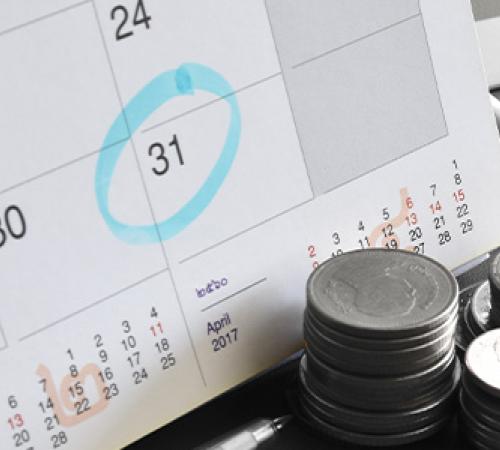

Find out what a cash flow forecast is, and the pros and cons of creating one, with our helpful guide.
What is a cash flow forecast in business?
A cash flow forecast can be a valuable tool in small business accounting. As the name suggests, it involves forecasting your cash flow over a specific period in the future. For example, this could be a particular financial quarter or a full year.
The forecasting process encourages you to think realistically about your future sources of business income, plus the regular outgoings you’re likely to face. By mapping them out in a cash flow forecasting model, it can be easier to identify any potential bumps in the road. It also allows you to get your finances in order ahead of time and prepare for both good months and tighter ones.
Cash flow forecasting also has broader uses that extend beyond the boundaries of your business. For instance, it can provide useful evidence to potential investors that you’ve got control over your spending. Find out more about managing cash flow for your business with our guide.
Why use a cash flow forecast?
There are plenty of reasons to use a cash flow forecast within your small business.
Getting early warning signs
Any months showing significant negative cash flow – where there’s more money flowing out of your company than coming in – will be worthy of investigation. This could help you plan for things like additional borrowing.
Comparing performance across departments
A cash flow forecasting model can project any departments or business areas that are likely to underperform or overperform in the months to come.
Modelling the impact of one-off purchases
Planning to take on extra staff or invest in new business equipment? Your forecast can reveal the short-term effects this might have on your cash flow.
Maintaining strong supplier relationships
Budgeting in advance will ensure you have enough in the bank to meet any financial commitments to suppliers and contractors.
Building investor trust
A transparent cash flow forecast can show potential investors, banks and other lenders that you take your accounting seriously. Being open and honest from the start will create the right foundations.
Cash flow forecast: advantages and disadvantages
Before drawing up a forecast, it’s a good idea to consider both the benefits and any potential challenges. Here are some common cash flow forecast advantages and disadvantages to think about.
Advantages of cash flow forecasting
The potential benefits of forecasting include:
- Complying with loan agreements. A forecast can help you stay on top of any debt covenants you face. These are rules set by lenders, requiring you to meet certain financial commitments.
- Charting a path to growth. Projecting cash flow on a monthly basis can help you set meaningful goals and financial targets.
- Flagging customer payment issues. You may be able to identify customers who regularly fall behind with their payments.
- Fluid process. Cash flow forecasts don’t have to be set in stone. You can adjust your figures over time if business or economic circumstances change.
Challenges with cash flow forecasting
The potential challenges when compiling a forecast include:
- Staying realistic. It may be difficult to generate meaningful insights if you only enter best-case figures. Always aim to be accurate with your data – even if it contains a few uncomfortable truths.
- Failing to adapt. Since cash flow forecasting only predicts future events, you may not want to rely on it too heavily.
- Finding the time. Manual data entry across different spreadsheets and systems often requires time, patience and close attention to detail.
- Gathering accurate, error-free data. It may prove tough to verify income and spending figures if lots of different departments are involved.
How do you do a cash flow forecast? Step by step
It takes a few simple steps to come up with a basic cash flow forecasting model. Here’s how to get started…
1. Choose a forecasting objective
Having an objective behind your cash flow forecast can help you retain focus and gather the right data.
It could simply be a case of managing the day-to-day liquidity of your company. Alternatively, you may choose to focus on long-term growth or ensuring debt repayments are covered.
2. Work out the right forecasting period
It may be best to decide whether you want to map out your cash flow in the short or long term. If you’re relatively new to the business world and lack hard data, bear in mind that your accuracy will decline the longer you plan for.
You can easily set things up in a spreadsheet: just add a column at the top for each month that’s covered by your forecast.
3. Add up your income
Create different rows on your spreadsheet to list each of your income sources. This could include things like sales, grants, loans and investments, for example. Then, enter the projected income you expect to receive from them each month.
At the bottom of each monthly column, add up the total income from all these sources.
4. Calculate your expenditure
It’s then just a case of doing the same for your regular expenses. List each one in a different row on your spreadsheet, enter the expected amount for each month, and add them all up at the bottom of each column.
Tax, spending on marketing, property and material costs, and wages are just a few of the things you could include here. Learn about some of the other costs involved in starting a business with our guide.
5. Do some simple maths
The good news is that you don’t have to be a mathematical expert to work out your projected cash flow for each month. In fact, it only involves a simple sum.
Just subtract your total outgoings for a particular month from your overall income. If the figure is negative, you’ve got a negative cash flow, where more money is leaving your business than coming in. The opposite is positive cash flow, where you’re bringing in more than your expenditure.
If you’re forecasting a positive cash flow most months, you can start to plan for growth. However, a recurring negative cash flow may be an early warning sign of challenges ahead.
Why is a cash flow forecast so important?
Having an effective cash flow forecasting model can help you nip nasty financial surprises in the bud and confidently plan for the future.
It can make all the difference between an expertly run enterprise and one that is disorganised, offering reassurance to investors, employees and business partners alike.
Learn more about the financial and legal implications of running a business with our range of helpful guides.
Disclaimer:
At Hiscox, we want to help your small business thrive. Our blog has many articles you may find relevant and useful as your business grows. But these articles aren’t professional advice. So, to find out more on a subject we cover here, please seek professional assistance.






